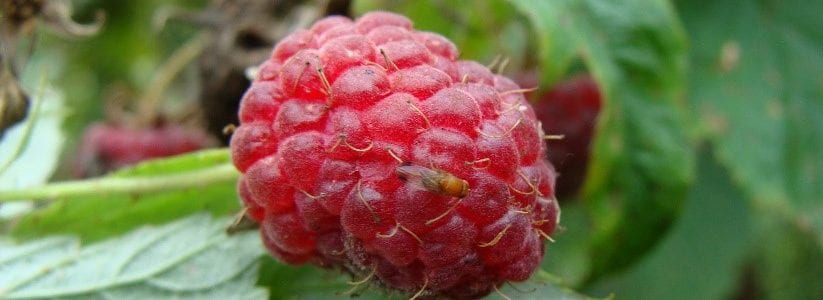Ten female and 30 male SWD were caught in four traps set in and around a raspberry planting in Albany County. Yes, this is the first catch at this location — last week zero, zilch, nada. Talk about accelerated population growth! These traps are being monitored by Natasha Field, Eastern NY Commercial Horticulture Program (ENYCHP), Cornell Cooperative Extension. The traps were checked on June 15, 2020. Fruit is small and green and, therefore, not susceptible to egg-laying. But...
Are you managing a diversified fruit farm?
With SWD numbers this high, 40 SWD, any fruit that is susceptible, ripe and ripening will be at risk of infestation. Please sample your June strawberry harvests and sweet cherry harvests and check them via salt flotation.

Information is summarized in this pdf, Guidelines for Checking Fruit for SWD Larvae in the Field, authored by Laura McDermott, ENYCHP.
Always consider the sum total of management tactics you can do to thwart this insect. One thing at this time of year for diversified fruit farms is careful attention to strawberry harvests and field renovation. Laura McDermott and I wrote a blog on this topic, which you should review now. Renovate Strawberry Plantings Promptly, blogs.cornell.edu/swd1/2018/06/27/renovate-strawberry-plantings-promptly/
Pest management for SWD includes:
- Mowing – to reduce humidity and niches for SWD harborage and to increase sun penetration.
- Weed management – to reduce humidity, alternate fruiting hosts and harborage and to increase sun penetration.
- Pruning – to reduce humidity and to increase sun and spray penetration.
- Monitoring – to know if SWD is present when fruit is ripening.
- Sanitation – to reduce reproduction harborage and overall SWD population.
- Cold storage – to slow or kill any eggs and larvae in harvested fruit.
Am I repeating myself? –yes!
Should you pay attention? –yes!
SWD Management, http://fruit.cornell.edu/spottedwing/management/ on Cornell Fruit Resources.
Insecticide Quick Guides for NY State are found here:
- For berry crops http://www.hort.cornell.edu/fruit/pdfs/swd/berry-insecticides.pdf
- For stone fruit and grapes http://www.hort.cornell.edu/fruit/pdfs/swd/treefruit-grape-insecticides.pdf
Refresh the page to see the latest version.
Learn more about SWD. Check out the information on Cornell Fruit Resources Spotted Wing Drosophila, fruit.cornell.edu/spottedwing/.

